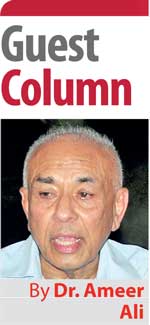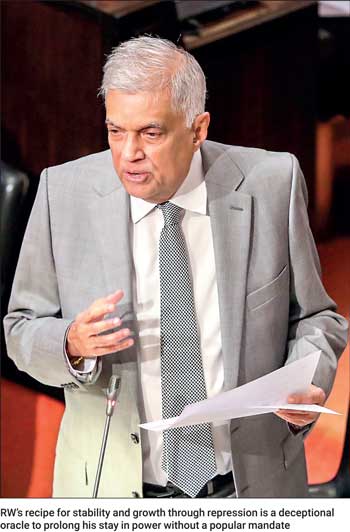Sunday Apr 20, 2025
Sunday Apr 20, 2025
Saturday, 10 December 2022 00:10 - - {{hitsCtrl.values.hits}}
“Nothing doth more hurt in a state than cunning men pass for wise” – Francis Bacon

Before becoming President and prior to that Prime Minister, Ranil Wickremesinghe appeared as the man for the season and peacemaker in a chaotic political environment created by Aragalaya youth. RW sympathised with their cause for systemic change and even appealed to the police not to invade Galle Face Green to chase out the agitators by force, but to protect them from an angry mob that was marching to attack them after listening to a provocative address by the then Prime Minister, Mahinda Rajapaksa. If not for the Aragalaya, RW would not have had the opportunity to become what he is today.
Having climbed to the top on the back of those protestors he is now directing his anger at them and announcing that he would not tolerate another Aragalaya. He also announced that he would not call for elections until the economy is stabilised and put on a growth path as per the 2023 Budget, and the Tamil national question is resolved, without outside interference, before the 75th Independence Day. In short, in the name of stability, growth and peace, but without conceding to Aragalaya demand for systemic change, RW, like his predecessor, has chosen to work with the existing system with repression as a tool for success.
Why another Aragalaya?
A wolf in sheep’s clothing would be the apt idiom to characterise the post-Aragalaya personality of RW. A man who showed sympathy with the agitators’ call for systemic change is now trying to create socio-economic wonders without that change. All that he has done so far and would continue to do in future is to fine tune the system in vogue and dubbing that tuning as systemic change. An old political adage, “If you cannot beat them join them”, seems to fit the survival strategy of this cunning President.
The existing system of political power sharing, public administration and economic management is so corrupt that one may justifiably call that system itself as corruption. Corruption has become part of the national culture and way of life. Even the IMF identified this evil as the number one enemy and set its eradication as one of the conditions for financial assistance, economic stability and revival. The irony is that the captains of corruption who nurtured that system and brought the economy to ruins are still calling the shots in parliament, and the President is their captive. Even if he genuinely believes in systemic change, his hands are tied without a mandate from people.
 The Aragalaya, which initiated whatever political changes that happened over the last few months, represents the yet unfulfilled yearnings of a new generation of young men and women from all ethnic, religious and cultural groups, whose vision of a model Sri Lankan society, its economy and governance is shaped by a world which is vastly different from the one in which their elders were born and grew. The youth of today are an awakened generation living in a digitalised world of information technology that feeds them with surfeit of details on developments happening outside their immediate surroundings. The gadgets they carry and play with make it possible for them to cross-check information they receive for its veracity, which make these youth less gullible than their parents to the charms of official propaganda.
The Aragalaya, which initiated whatever political changes that happened over the last few months, represents the yet unfulfilled yearnings of a new generation of young men and women from all ethnic, religious and cultural groups, whose vision of a model Sri Lankan society, its economy and governance is shaped by a world which is vastly different from the one in which their elders were born and grew. The youth of today are an awakened generation living in a digitalised world of information technology that feeds them with surfeit of details on developments happening outside their immediate surroundings. The gadgets they carry and play with make it possible for them to cross-check information they receive for its veracity, which make these youth less gullible than their parents to the charms of official propaganda.
Disappointingly, this vital fact seems little understood by an ageing political leadership holding power. RW’s Hitlerite proposition to disallow another Aragalaya, and propagating the myth that aragalaya has no public support is illustration of his refusal more than inability to grasp the dynamics of the intergenerational struggle that is universal.
An awakened youth with kingmaker ballot strength are the vanguards of an effective opposition outside the legislature. That a total of 94 academics from almost all universities in the country urging the people to rise against state repression will add sustenance to another aragalaya. The new generation may be leaderless for the time being, but that vacuum would be filled if a party like NPP fails to harness the strength of this vanguard and commit to a radical overhaul of the system in vogue. RW’s recipe for stability and growth through repression is a deceptional oracle to prolong his stay in power without a popular mandate.
Stability and growth
If the 2023 Budget is any indication, RW’s chosen road to economic stability and growth via an export oriented and technologically driven open economy is fraught with uncertainties to say the least. His distant target of the centenary year 2048 for Sri Lanka to join the family of First World nations is tacit admission of this uncertainty. Much has been said about the economics of the budget. That the prevailing economic situation in the country is dire and that it needs certain unpleasant measures to overcome are not in dispute. But what is in dispute is whether the measures the budget proposed would all be implemented in full and whether they alone would suffice to lead the economy to reach RW’s desired destination.
Implementation is the weakest element in the budget and that weakness arises from a rotten system. That the CBSL Chief Dr. Weerasinghe, who is aware of this problem, has presented a rosy picture to inject confidence in the economy and entice foreign investors to queue up for profiting is understandable.
RW’s obsession with the glitters of an export-oriented open economy has made him blind to realise the importance of a vibrant domestic counterpart to fall back if global uncertainties cripple export markets. An ongoing European war with no sign of ending soon, increasing frequency of devastating climate swings and a stubborn COVID-19 pandemic that refuses to go away can create supply rigidities, loss of markets and fall in demand to restrict exporting possibilities for small economies like SL. This is why a vibrant domestic market focused production sector is vital.
By putting all eggs in the basket of an export sector with a view to accumulate foreign exchange, RW’s budget falls short of adequate incentives to resuscitate a dispirited local production sector which, if rectified, could save foreign exchange by helping to cut down imports. Such incentives in the budget are too few and far between. This is why RW’s road to growth and stability looks rockier than what it looks in print and words.
In passing, one should also not forget that the export-oriented market model was the pet baby of RW’s mentor the late JRJ. Policy instruments such as free market, privatisation, foreign direct investment, export diversification and industrialisation were pillars on which JRJ designed his dharmishta samaagaya, as Prof. Sarathchandra baptised that model. JRJ embraced the open economy with vengeance and with a dream to re-make Sri Lanka into another Singapore, but without Singapore’s a-ethnoreligious and secular foundation. It is in this context one should consider the seriousness or otherwise of RW’s proposal to resolve the so-called Tamil national question.
Peace and national question
To begin with, it is a misnomer to call this a Tamil national question, because what the country faces is a national question about the future and status of all minorities, which include not only ethnic Tamils but also others, and more significantly, Muslims who are ethnically a mixed bunch of Tamil, Sinhalese, Malay, Arab and other blooded group. However, it is undisputable that ethnic Tamils have been the biggest losers since 1950s in the wake of a belligerent Sinhala-Buddhist ethnonationalist ideology. The physical and material losses and the mental and psychological agony that this community suffered because of that belligerency are incalculable and everlasting and they need a more statesmanlike approach at resolving the national question than a politically motivated polylogue as RW had suggested.
If the president is serious about resolving this problem and has the political courage, he should first unequivocally condemn the contention that Sinhalese are the sole owners of this island and that minorities are their long-term lease holders. This hegemonic untruth based on mytho-history dangerously discourages growth of patriotism among minorities. And that untruth was openly propagated in a public rally in 2020 by that obstreperous Buddhist monk Ven. Gnanasara, the Secretary of the supremacist Bodhu Bala Sena. No Sinhalese politician or leader since then, except the late Mangala Samaraweera, had the nerve to denounce it.
Instead, that untruth is continued to be purveyed by mischievous monks and malicious parliamentarians. For example, Mahinda Rajapaksa, on more than one occasion, had said that no province in the country belongs to any particular community, referring in particular to Northern and Eastern provinces. But he never dared to say the same when referring to the country as a whole.
Unless RW vows to protect Sri Lanka’s ethno-religious and cultural plurality, denounce the hegemonic aspirations of Sinhala-Buddhist monists and rewrite the constitution accordingly, his advertised polylogue with TNA, Muslim leaders and others is not going to deliver anything meaningful to resolve the national question. Sinhala-Buddhist hegemony is the axle on which the prevailing system spins. Removing that axle will be vital for peace in the country but politically suicidal to RW.
No economy can revive and thrive without the support and energy of its people. An economy is more than the sum of its goods and services and money and materials. It is the collective synergy of the people that ultimately makes an economy robust, dynamic and victorious. A divided and discontented nation like Sri Lanka lacks unity to start with to generate that synergy. To foster that unity the national question should be resolved and that requires not power-hungry politicians but patriotic statesmen and stateswomen. The Aragalaya generation is the best hope for this.
(The writer is attached to Murdoch Business School, Murdoch University, Western Australia.)